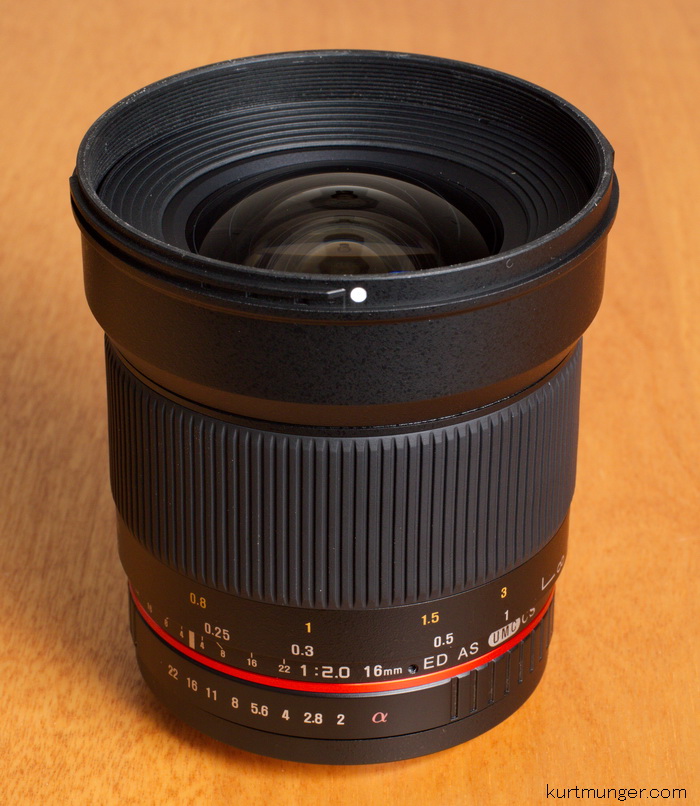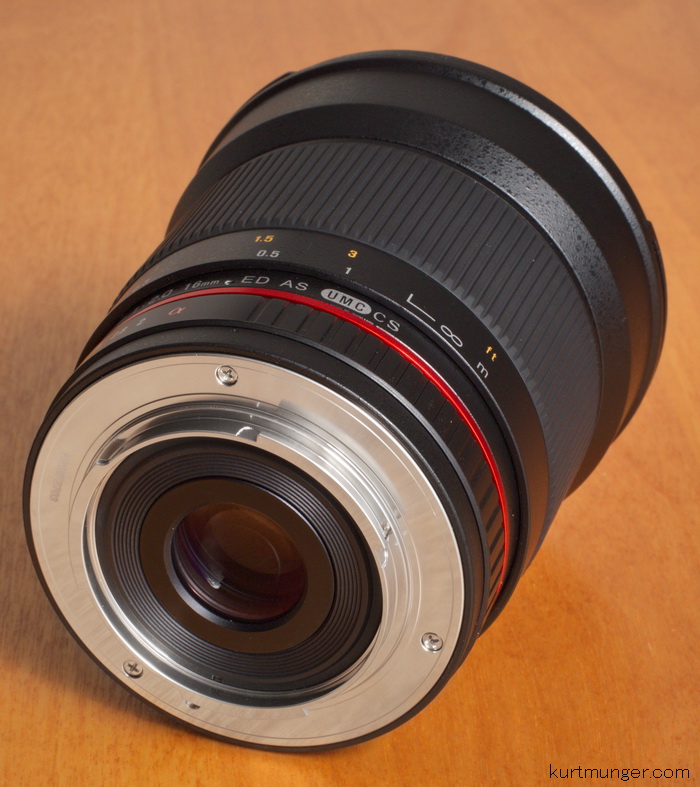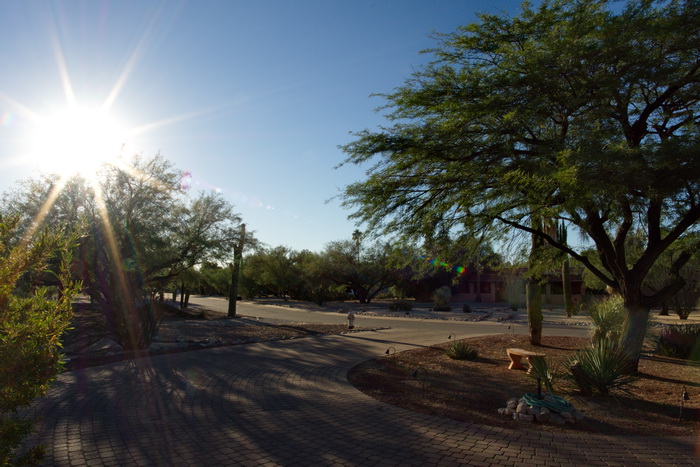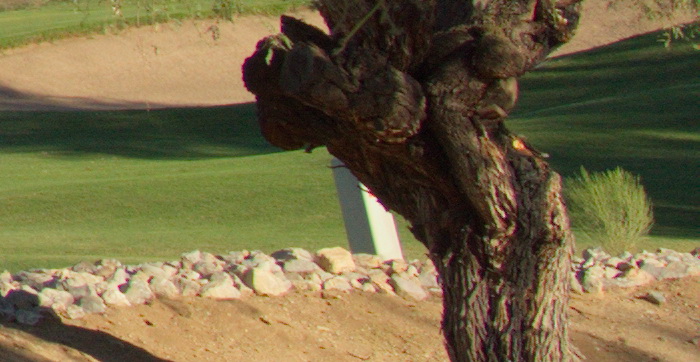Full review of the Rokinon 16mm F/2 lens, also labeled Samyang.
 |
| Box and contents |
The Sony A77 was used for this review. For a better understanding of terms and methods used in this review, go here. The usual center, mid-section and corner crops are located at the very bottom of the page.
Introduction.
The wide angle and relatively inexpensive Rokinon 16mm F/2 UMC aspherical lens was introduced in 2013, and is available for most major camera mounts, including Sony A and E. It may also be found labeled walimex, Falcon, Opteka, Pro Optic, Vivitar, Bowers and Samyang. I’m told Samyang of South Korea is the original manufacturer. The lens says “made in Korea.” This is an APS-C only lens, meaning it’s made specifically for that type of sensor, however it can be used on full frame sensor cameras, but it reduces the capture area.
Found on the outside of the lens is a plastic aperture ring and plastic manual focusing ring, no focus hold or limiter buttons. Build materials of the body seems to be a mix of metal and plastic. Build quality is generally good, with a good fit and finish. Additionally, the plastic filter ring at the front that surrounds the front element is thin, and bends with finger pressure. Make sure you don’t strip the threads when mounting a filter. The lens body has an appealing black spatter paint finish. Rokinon claims the use of at least one aspherical element in the design of the lens.
Use. Make sure you select “enable” for “release W/O lens” on your camera, otherwise, the camera thinks no lens has been mounted, and won’t release the shutter. This is a manual lens only, meaning there is no communication with the camera (on a Sony model), you must use manual focus, and choose an aperture. Exposure metering is ok, but you’ll need to check your LCD after each shot and adjust for best results. Also, white balance metering may change as you stop down the aperture. The aperture settings are marked in one stop increments (half stop licks in between those marks) F/2-F/16, there is no stop between F/16-F/22. It is possible to use an in-between aperture, you’ll have to carefully turn the ring and set it between marked stops, although I don’t know why you’d want to do that. The viewfinder is very dark when the aperture is set smaller than F/5.6.
Don’t set the lens down on the mount side without a cap when the focus is set to infinity, if you do the rear element will touch the surface and the lens will wobble around and fall over.
Note; bright daytime use at F/2 will often result in having to use a shutter speed of 1/4000 at ISO 100. Many Sony cameras start at ISO 200, so you’ll need to use a neutral density filter to bring down the light value and get the proper exposure. The aperture blades form a nice circle between F/2-4, however, from F/4-22 the hole increasingly becomes octagonal.
EXIF data reads 0mm for focal length, and F/0 for aperture. The live view screen will read F– with no aperture.
In the box is the lens, front and rear caps, plastic petal type hood, a stinky black fake velvet carrying pouch and owner’s manual.
Focusing. Manual focusing only. The focusing ring is damped perfectly in my opinion, and is pretty easy to turn with one finger. Focus ring travel is almost 1/2 of a turn from close-up to infinity, which is a good amount of travel, and should be plenty to get perfect focus.
 |
| Side shot |
 |
| Back side, no contacts |
General information and specifications.
|
Lens
|
Rokinon 16mm F/2 ED AS UMC CS for Sony
|
|
Box contents
|
Front cap, rear cap, hood, carrying bag and users manual.
|
|
Cost
|
Approximately $429 depending on branding.
|
|
Build quality
|
Ok to good.
|
|
Additional information
|
Introduced in late 2013. May also be marketed under the names; Falcon, Bowers, Samyang, Opteka, Pro Optic, Walimex, Vivitar.
|
Specifications below
|
|
|
Optical configuration
|
13 elements in 11 groups
|
|
Angle of view
|
83.1˚
|
|
Aperture
|
8 blades, slightly curved
|
|
Full frame and APS-C
|
Made for APS-C cameras, with equivalent coverage of about 24mm, Micro 4/3 about 32mm.
|
|
Depth of field and focus scales?
|
Yes, DOF, aperture index marks and focus distance scale.
|
|
Minimum focus, image plane to subject
|
About 7.9″ (200mm)
|
|
Minimum focus, end of lens barrel to subject
|
About 2.4″ (36mm)
|
|
Hard stop at infinity focus?
|
No, goes slightly beyond infinity.
|
|
Length changes when focusing?
|
No.
|
|
Focus ring turns in AF?
|
N/A
|
|
Filter size
|
77mm.
|
|
Filter ring rotates?
|
No
|
|
Distance encoder?
|
No
|
|
Max magnification
|
Approximately 0.18x or 1:5.5
|
|
Min. F/stop
|
F/22
|
|
Sony teleconverter compatible?
|
No
|
|
Length changes when zooming?
|
N/A
|
|
Dimensions WxL (my measurements)
|
3.27″ x 3.5″ 83mm x 89mm.
|
|
Maximum extended length (my measurements)
|
3.5″ (89mm)
|
|
Weight bare (my scale)
|
19.9oz (563g) bare.
|
Optical qualities summary.
Lens flare/ghosting. About average control. At large apertures I see some multi-colored rings that may ruin the image, but stopping down results in mostly isolated colored blobs when the sun is close to, or inside the shot, see examples below.
Light fall-off. Heavy at F/2, but brightens up at F/2.8. See samples below.
Color fringing (CA). Lateral color fringing control is about average. I see a little magenta and green at the edges of the image. You see minor amounts of axial color fringing, but it clears up by F/4.
Bokeh. Fairly smooth at large apertures, harsh at small apertures, see examples below.
Color. seems slightly warmer (more yellow/orange) than Sony lenses.
Close up filter. N/A
Coma. almost none at F/2.
Regular filters cause no additional light fall-off on APS-C or full frame cameras.
Filter size. 77mm. Sony uses this size on the CZ 24-70mm F/2.8, 70-200mm F/2.8 G, CZ 135mm F/1.8, 11-18mm F/4.5-5.6, and the 70-400mm G.
Distortion. mild to moderate barrel distortion.
Distortion example directly below.
 |
| Minor to moderate barrel distortion |
The distortion is typical wide angle barrel, with the ends flattening out. Mostly correctable (but not fully) in post processing with distortions sliders.
Bokeh samples.
Bokeh looks smooth at F/2, but does get a dot in the center at F/4 and smaller. The octagonal aperture shape shows up when stopped down past F/4.
Light fall-off samples.
Light fall-off is somewhat heavy at F/2, but improves greatly at F/2.8.
Flare and ghosting.
 |
| F/11 or F/16, not sure. |
Here’s a full scene that shows a sun star, flare, and multi colored ghosting. Just be careful when shooting into the sun or other super bright light source. I think this was taken at F/11 or F16, can’t remember exactly.
Lateral color fringing.
I see a little magenta and green along high contrast areas, like the tree trunk against the sand trap. This is easy to remove in post processing when saving your files as RAW.
Let’s check out the macro capabilities of this lens.
Below, check out the cropped image of the stamp. The sample shot was taken with the Sony A 77 24MP camera. The subject is a standard US stamp, 0.87″x 1.0″ or 22mm x 25mm. Also, note the macro shot was taken as close to the subject as focusing allowed; in this case a short 2.4″ (36mm), measured from the front of the lens barrel to the subject.
This lens has an approximate reproduction size of 0.18x (1:5.5) which is about average for today’s wide angle prime lenses. The stamp shot looks pretty good, with nice color and contrast. The lens is so close to the stamp it was hard to get the whole thing in focus, it’s slightly soft along the sides, mostly visible at the bottom left corner. As a side note; the “1996” on the bottom left of the stamp measures a mere 1mm wide.
 |
| As close as you can get, F/5.6. |
Conclusion.
Optically speaking, the Rokinon 16mm F/2 is excellent, but only in a narrow range, like F/4-5.6, stopping down to F/8 or smaller results in serious diffraction, and makes the image look soft. At wide apertures, like F/2-2.8, the image is also soft, even in the centers, which I didn’t expect. A prime lens should be very sharp in the centers at F/2.8, however, along the sides one shouldn’t be so critical at these apertures.
In other areas, ghosting control is slightly below average, so watch out when the sun is near, or inside the image. Color fringing control is noticeable along the sides of the image, but easy to correct in post processing when saving as RAW. Close focusing results in a sharp image, but there isn’t much ‘working’ room as the front of the lens barrel is only a little over 2″ (50mm) from the subject, and if you have the hood on, it almost touches the subject! Distortion as well as light fall-off patterns are pretty typical of a wide angle lens. Coma control is excellent, and is not noticeable in real images.
Would I recommend this lens? First off, I tested two copies of this lens, the first was very soft on the left side, the second copy was much better, but still a little soft on the left side, but I thought it was acceptable, and probably not noticeable unless you view crops side-by-side at 100% on your computer screen. Here’s the problem; I doubt there is any ability to correct problems with this lens if there really is a problem, like a tilted element or de-centering etc, if you send it in, they’ll probably tell you it’s ‘in spec’ whether it’s sharp or not to you, and if it’s really off, they’ll send you another copy. Good luck with that. This lens is quite inexpensive, so you pay your money and take your chances, just like at the fair grounds. To answer the question at the start of the paragraph, I probably wouldn’t recommend this lens, especially to the novice. It’s manual focus, manual aperture control and may have quality control issues. If you have experience with other manual only lenses, and don’t mind taking some chances, then you might wind up with a good lens. There currently isn’t much else available for Sony ‘a’ mount users, so if this is your focal length, then you might give it a try.
Bottom line: a very good lens at F4-5.6, just mediocre everywhere else. Sony ‘E’ mount users; spend less money and get something better, like the Sigma 19mm F/2.8, which isn’t quite as wide or fast, but it performs better over a broader range, and is much smaller and lighter. |
































